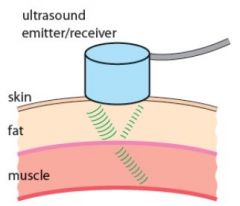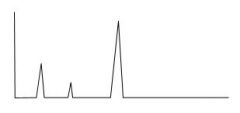![]()
![]()
![]()
Use LEFT and RIGHT arrow keys to navigate between flashcards;
Use UP and DOWN arrow keys to flip the card;
H to show hint;
A reads text to speech;
19 Cards in this Set
- Front
- Back
|
What is ultrasound? |
Ultrasound is the name given to sound waves with very high frequencies. |
|
|
What frequency range is ultrasound? |
Ultrasound waves have frequencies above about 20,000 Hz (which is 20 kHz). |
|
|
What type of waves are ultrasound? |
Longitudinal waves - All sound is produced by vibrating particles that form longitudinal waves. In this kind of wave the vibrations of the particles are in the same direction as the wave. |
|
|
Longitudinal waves are described in terms of Amplitude, Wavelength, Frequency, Compression and Rarefaction. What do these terms mean? |
Amplitude - The maximum distance the particles move from their normal position. The louder a sound is, the more energy it carries and the bigger its amplitude.
Wavelength - The distance between one high pressure region (compression) and the next. Frequency - The number of waves produced in one second, measured in hertz, Hz. A higher pitched sound has a higher frequency than a lower pitched sound. Compression - A region of higher pressure where particles are squashed together. Rarefaction - A region of lower pressure where particles are spread out. |
|
|
What is the range of human hearing? |
The range of human hearing is about 20 Hz to 20,000 Hz. |
|
|
What medicinal uses has ultrasound? |
Like X-rays, they can be used to diagnose disease, and they are also widely used in pre-natal scans to check the development of an unborn baby. Ultrasound is also useful in the medical treatment of kidney stones. |
|
|
When ultrasound waves reach a boundary between two media (substances) with different densities, they are partly reflected back. A detector placed near the source of the ultrasound waves is able to detect the reflected waves. It can measure the time between an ultrasound wave leaving the source and it reaching the detector. Which equation can be used to calculate the distance travelled by the ultrasound wave? |
The distance travelled by an ultrasound wave can be calculated using this equation: s = v × t s = distance in metres, m v = speed in metres per second, m/s t = time in seconds, s |
|
|
Give an example of an industrial use of ultrasound. |
An ultrasound machine can be used to detect cracks or flaws in materials such as metal. This is used in industry for quality control procedures to check manufactured objects, such as railway tracks and oil pipelines, for damage or defects. |
|
|
Explain how ultrasound is used in medical imaging? |
The human body is composed of different tissues such as muscle and skin. Ultrasound directed at the body will be partly reflected at the boundary between these different tissues. This principle is used in ultrasound scans. These are widely used in pre-natal scanning to check that a foetus is developing normally and to take measurements of its growth. Computers can combine many ultrasound reflection readings to produce a detailed image from them. |
|
|
Explain how ultrasound is used to remove kidney stones?
|
Kidney stones are solid crystals formed from substances found in urine. They can sometimes build up into large stones inside the kidney.
High frequency ultrasound waves focused at a kidney stone cause it to vibrate, breaking it into small enough pieces to pass out in the urine. |
|
|
Compare ultrasound and X-rays |
Compared to ultrasound, X-rays have a much shorter wavelength (higher frequency). This means that X-ray photographs produce higher quality images than ultrasound scans. They show greater detail and clarity. This is vital in terms of detecting small bone fractures or abnormalities. CT scans provide even higher quality images than normal X-ray photographs. The 3D images produced by CT scans allow analysis of different levels through the body without other structures obscuring the area of interest (as can happen with traditional X-ray imaging). |
|
|
Why is Ultrasound safe to use when performing a foetal scan as opposed to X-rays which are not? |
X-rays are ionising which means that X-rays damage living tissue and the DNA within cells. Rapidly dividing cells are particularly vulnerable to the effects of ionising radiation. This makes X-rays particularly damaging to a developing foetus. Ultrasound waves are not ionising, and so they are safe to use when performing a foetal scan. |
|
|
(a) Why can’t we hear the sounds produced by bats?
(b) How do we know that bats produce ultrasound if we cannot hear it? |
(a) Bats use ultrasound, which is at too high a frequency for humans to hear.
(b) We can use microphones to detect the sounds. |
|

The ultrasound machine in the figure receives echoes from the top of the layer of muscle 6.5 × 10^–6 seconds after the pulse is emitted. Assume the speed of sound in muscle tissue is 1600 m/s. Some of the ultrasound waves emitted by the machine are reflected at the boundary between fat and muscle. How thick is the layer of muscle? |
s= v× t
= 1600 m/s × 6.5 × 10^−6 s = 1.04 × 10^−2 m (or 1.04 cm). Thickness of muscle = 0.52 cm. (Or similar working with the time halved before being used in the equation). |
|

The figure shows ultrasound being used to measure the thickness of three layers of material in a model of part of the body. From which interface in the figure is the ultrasound reflected most strongly? |
Interface 1, as the echo has the highest amplitude. |
|

The model shown in the figure is made from layers of material in which sound travels at approximately 1540 m/s. It is 2.4 cm thick. How long does it take the echo to return from the back surface? |
total distance travelled = 2 × 2.4 cm = 4.8 cm = 0.048 m. Time = distance/speed = 0.048 m / 1540 m/s = 3.1 × 10^–5 s. |
|

Sketch an oscilloscope trace showing a plate similar to the one in the figure, with a larger defect just above a smaller one. Explain your sketch. |

The larger defect will reflect more ultrasound, so it will make a larger spike on the trace. If it is above the smaller defect, the reflected ultrasound from it will arrive first. |
|

Look at the figure showing an oscilloscope trace from an ultrasound machine. 1 microsecond (μs) = 10^−6 seconds. How deep within the model is the interface between the two layers of tissue? |
Time for echo to return = 2.2 μs(approximately) = 2.2 × 10^–6 s. Time for ultrasound to reach the interface =1.1 × 10^–6 s. Thickness = 1540 m/s × 1.1 × 10^–6 s = 1.69 × 10^–3 m or 1.69 mm. |
|
|
What are the key points to remember? |
Ultrasound waves are sound waves that are above 20 000 Hz, which is the upper limit of human hearing. Ultrasound waves can be produced by electronic systems. Ultrasound waves are partially reflected when they meet an interface between two different materials. The time taken for an echo to return to a detector can be used to determine the distance to the interface. Ultrasound can be used for imaging the human body, mapping the sea bed and detecting defects inside metal objects. |

